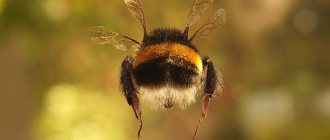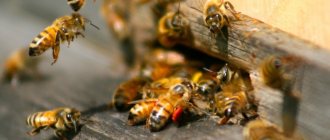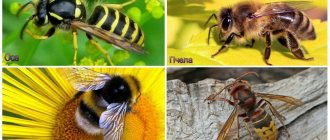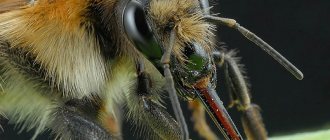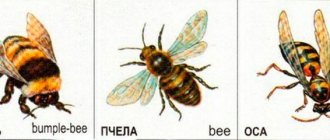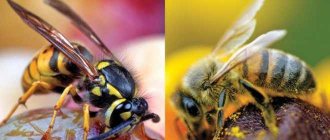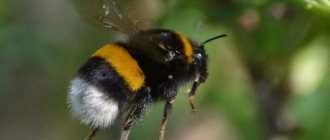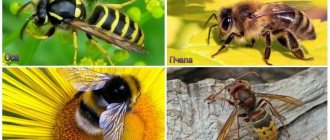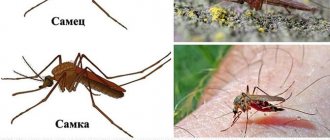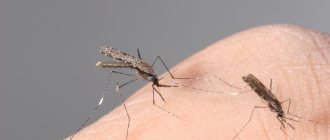| « | According to the laws, you know, modern aerodynamics mean that a bumblebee cannot fly. You shouldn't fly, you bastard! And he flies... an illiterate insect bitch. | » |
| — Weller, “Seryozha Dovlatov’s Knife” | ||
Bumblebee doesn’t care what they say about him.
A bumblebee shouldn't fly
- a well-known “scientific” paradox, in fact, has long ceased to be such, but is still often reproduced by various narrow-minded individuals. Sometimes a cockchafer is substituted for a bumblebee, but this does not change the essence.
This boyan goes like this in full: “According to the laws of physics, a bumblebee should not fly, but he doesn’t know about it and flies anyway.”
. Just such a formulation of the problem will cause not only a scientist, but also any sane person who understands that science is not intended to fence humanity off from the outside world, but to understand this world rationally. But first things first.
[edit] Background
The essence of the problem for the little ones: a fat guy with tiny wings.
The birth of the subject is covered in legends and dates back to the beginning of the twentieth century, when one great-wise scientist (different names are called, almost Ludwig Prandtl himself) decided to calculate the lifting force of the wings of a bumblebee. Why bumblebee? The bumblebee, an insect with the symbolic Latin name Bombus, has too small wings relative to the size and weight of its own body, but still manages to fly, and therefore is of particular interest for research.
Since this was only at the dawn of aerodynamics, the scientist applied formulas for calculating the lifting force of aircraft to the bumblebee, as a result of which he suffered a failure and concluded that the bumblebee should not fly and actually does so contrary to the laws of physics. Even if this is true, he did all this, most likely, exclusively for the lulz, because he could not help but understand that an airplane, unlike a bumblebee, does not flap its wings, its flight mechanics are completely different and by definition it belongs to bumblebees doesn't fit. The study of insect flight was thus waiting in the wings. However, the bumblebee, trampling the foundations of the universe, without waiting, became memetized and flew off to the people, where it gained wide popularity both as an argument in favor of the powerlessness of science, and as a suitable catalyst for the SRSG, and simply as a joke, which is not a sin to amuse friends with a glass. work colleagues.
A bumblebee cannot fly according to the laws of aerodynamics?
First, let's delve into the theory and see if science really contradicts the ability of bees of this species to move in airspace.
Scientists once studied the flight characteristics of insects with special care, because it was on their basis that assumptions were made about the possibility of human flight in the air using some means, which ultimately led to the creation of paragliders, and later airplanes.
Using aerodynamic analysis, the flights of many winged arthropods were tested. However, when it came to the hero of our article, scientists were at a dead end. All the calculations they used previously were not suitable.
The point turned out to be that in all studied representatives of the animal world, the body area was correlated with the area of the wings in equal proportions. And these bees, as you know, have wings that are much smaller than their body.
That is why the opinion arose that such bumblebees are not able to break away from the surface, since the surface area of its small wings is not enough to lift its voluminous body from the ground . The bumblebees, meanwhile, continued to fly.
[edit] In the world
A bumblebee shouldn't, but the bees don't know, oh.[1]
In those days, it was indeed hardly possible to adequately study the flight of insects simply because the level of photographic equipment for a long time did not allow recording the exact trajectory of their wings. With the achievement of this, as well as the development of this same aerodynamics with the discovery of new laws and principles, the subject gradually began to lose its aura of mystery and not so long ago lost it completely. Now the Internet is filled with jubilation that yet another British scientist has once again “refuted the common misconception that a bumblebee cannot fly.”
Nevertheless, the subject in its original form is still predictably popular on social networks[2], as is known, a little less than completely filled with lovers of “spectacular” quotes and demotivators of varying degrees of illiteracy, not accustomed to checking the bullshit they subscribe to. Also, this wise thought is slightly exaggerated in the cartoon “Bee Movie. Honey Plot,” but the bee shouldn’t be flying there anymore.
Truth or myth?
So, how should we perceive the widespread opinion that this representative of the fauna should not fly? What's the final verdict?
And it is unambiguous - these insects get off the ground without any problems, and this does not contradict any laws . You just need to dig deeper, and then it will become clear that the movements of the wings of this large bee fit perfectly into the rules of aerodynamics.
So, the expression that the movements of this creature in the air are impossible due to the fact that they run counter to the generally accepted postulates of natural science is false . However, it is firmly entrenched in the minds of ordinary people due to a long-standing mistake of scientists.
[edit] Debriefing
Slo-mo
The mechanics of the flapping flight of insects is a really complex matter, and a person far from physics will hardly be able to fully understand it, much less explain it to another, simply by reading its description. As for the bumblebee specifically, the essence can be explained in a very simplified way: with fast, fast flapping of the wings, which have a certain flexibility and trajectory of movement, annular turbulences of air are formed at their edges, which are “dumped” at the end of the flapping and create the necessary lifting force for the insect and determine direction of movement.
It should, however, be noted that the bumblebee, despite the use of advanced achievements in biomechanics, is far from the most sophisticated flyer among its arthropod counterparts. Millions of flies fly in a similar way to a bumblebee, but at the same time, for a number of reasons, they are more adapted to that very aerobatics, which causes tons of hatred in the anonymous person and makes their subsequent extermination very difficult. But butterflies, who are more savvy in physics, are able to use various principles in the process of movement, not limited to the release of air flow. They, too, stubbornly did not fit into any theories until high-speed filming deflowered their secret. The cruising flight of butterflies is no less cunning than that of a bumblebee: butterflies “applaud” their wings, closing them first at the ends, and then over the entire area. The air from this tube, as it collapses, is pushed back, vigorously pushing the painted creature forward and upward. In addition, butterflies know how to glide, spreading their wings, where a bumblebee, having done the same, simply hits its butt on the ground.
- A fly riding a whirlwind.
- Vertical take-off butterfly.
In the end, all that remains is to once again kneel before Mother Nature, who created such complex and perfect flight mechanisms for her insect offspring, despite the fact that there is still no special profit from their research - there is an opinion that on a human scale, insect flight is not the same physics will not allow it to be reproduced, but that’s a completely different story.
How does a bumblebee fly?
Faced with this phenomenon, the researchers continued to study this amazing insect, since the conclusion they reached seemed completely absurd.
Then various experiments began to be carried out to observe creatures that so easily crossed out all the laws of physics. With the help of modern technology, their flight was filmed with an ultra-precise camera, and then slowed down tens of times. Thus, it was possible to clearly see the entire process of movement of the insect’s wings.
It turned out that despite the apparent weakness, the wings of the arthropod are capable of developing incredibly high speeds. So, in one second, a representative of the fauna makes almost 400 strokes .
However, the most important discovery was the fact that bombus wings have two types of movement:
- The usual back-and-forth movements that are characteristic of all insects;
- Almost invisible to the eye, small tremors are vibrations at a high frequency.
It was this second type of movement that became the reason why this creature moves above the ground.
Why did the error occur?
How could it happen that a false theory spread throughout the planet and settled in the minds of ordinary people for a long time? How could scientists imagine that such an ordinary creature could live contrary to the laws of nature?
As it turned out, the problem was that the approach to the research and rules of aerodynamics was not sufficiently deep. Scientists made several mistakes during their research, which led to the birth of the myth:
- The assumption that, in accordance with physical postulates, and should not move above the surface, was put forward due to a lack of knowledge and awareness in the field;
- Moreover, when researchers studied the flight characteristics of other animals, they applied a single formula to all of them, which was based on the formula for movement in the air of an airplane. And here there were two pitfalls that escaped the attention of people of science;
- Firstly, the wings of an airplane are static, while in this arthropod they are constantly moving, and in several planes ;
- Secondly, the side of this aircraft is proportional to its wings, and the body of the bumblebee is much larger.
Thus, an insufficient amount of information led to the birth of a false theory. However, one should not think that people of science were simply stupid.
The reason for such an error was only the insufficient amount of information known to scientists at the time when the research was carried out. Since at that time such a branch of physics as vortex aerodynamics was not fully studied.
To summarize, it is worth noting that not all common facts are worth believing, since quite often they turn out to be just common misconceptions caused by error or misunderstanding. In the end, despite all the scientists' assumptions, bumblebees flew even when researchers thought they couldn't. And they continue to do so now.
The structure of the wings of a bumblebee in comparison with an airplane
There is a whole science - bionics, a science that combines technology and biology.
She studies different organisms and what people can learn from them. People often take something from nature and study it carefully. But the bumblebee for a long time haunted scientists, or rather its ability to fly.
Expert opinion
Valentin Lukashev
Former entomologist. Currently a free pensioner with a lot of experience. Graduated from the Faculty of Biology of Leningrad State University (now St. Petersburg State University).
One day, with my inquisitive mind and great desire to figure out unusual secrets, I learned the answer to the question “why does a bumblebee fly?” There will be many technical nuances, I urge you to be patient.
Physicists have established that the plane flies thanks to the complex design of the wing and aerodynamic surface. Effective lift is achieved by the wing's rounded leading edge and steep trailing edge. The engine's thrust rating is 63,300 pounds.
The aerodynamics of flight of an airplane and a bumblebee should be the same. Scientists have proven that according to the laws of physics, bumblebees should not fly. However, it is not.
Large bumblebee and its wings.
Bumblebee wings can create more lift than scientists expect. If the plane had the proportions of a bumblebee, it would not have left the ground. The insect can be compared to a helicopter with flexible blades.
Having tested the theory applicable to the Boeing 747 in relation to bumblebees, physicists found that the wingspan ranges from 300 to 400 beats per second. This is possible due to the contraction and relaxation of the abdominal muscles.
The drawn patterns of the wings as they flap are the cause of the different aerodynamic forces. They contradict any mathematical theory. The wings are not able to swing like a door on a regular hinge. The upper part creates a thin oval. The wings can flip with each flap, pointing the upper portion upward during the downward flap.
The flapping frequency of large bumblebees is at least 200 times per second. The maximum flight speed reaches 5 meters per second, which is equal to 18 km per hour.
Notes
- Sometimes a cockchafer is substituted for a bumblebee, but this does not change the essence.
- You just need to type “bumblebee fly” in the VKontakte news search
| [ + ] Bumblebee flying is not an official discipline of the Special Olympics. For more information, visit the Special Olympics portal. | |
| Politote | Armatosrach • Baltosrach • Bulbosrach • Great Patriotic War • St. George's Ribbon • Civil War in Russia • Gogisrach • Euromaidan • Are Russians Europeans? • The Iranian question • How can we develop Russia • Lend-Lease • Moskvosrach • National idea • Potsreots vs Liberasts • Pshekosrach • Russophobia • Sovkosrach • Khokhlosrach • Ympers vs Separatists • Political correctness • Mausoleumsrach • Tatar-Mongol yoke • Falsification of history |
| Other assholes | Abortion • Avtosrachi • Bogosrach (Atheism • æ Atheism • Orthodox atheism) • Is bodybuilding a sport? • Useless science • V/Na-srach • GMO • Friendship between a man and a woman • Zhanrosrach • Polivanov's system • Quantosrach • The book is better • Copysrach • Coffeesrach • Blood feud • Chicken or the egg? • Musical plagiarism • Violence in games • Legalize • Lunosrach • They sold out • Pyramidosrach • Platformosrach • Plutonosrach • Psinosrach • Psychoanalysis • Vaccinations • Rulesrach • Rusichesrach • The death penalty • Srach in demotivators • Typography • Phallometry • Ethological theory of Protopopov • Juvenile justice • Southern ocean • X is not dead |
| Other holivars | Windows vs. Linux • Mac vs. PC • TeX vs. WYSIWYG • Anime or not? • Vegans vs “meat eaters” • Will it take off or not? • Vinylophiles vs vinylphobes • Ovulians vs. Childfree • Pedivicia vs. Toradiciyo • Marioboy vs. Sonyboy vs. Billyboy • Men vs women • Science vs religion • True vs. Poser • Physicists vs lyricists • Shipping • A bumblebee should not fly |
| Local special competitions | Vandalism • War of edits • War of Friday the thirteenth • Dialogue with yourself • Breathing • Fuckery • Scratch in the notes |
| Laureates | AlexSword • Avanturist • Alksnis • Leonid Vasilevsky • Goblin • Zhenya Dukhovnikova • Katya Gordon • Zukagoy • Mitsgol • Svistunov • Okhrimka • Peysatel • Plyukha • Guinness World Record Holders • Stillavin • Churlyaev • Yarovrat • Ruslan Karmanov • Petya the Superman • Shmukler |
| Team race winners | Grammar nazi • Shitheads • Culinary snobs • Oppositionists • Socionics |
| Indications for participation | Butthurt • • Active civic position • Boklanopoctitis • Inadequate degree • Women's logic • Moralfatism • Over-brain • Watchman's syndrome • Mourner's syndrome • Duckling's syndrome • Subculture • ChSV • FGM • Youthful maximalism • |
| Stadiums | Check you • Fandom • Questions and answers (Google • mail.ru • Yandex) • Hansa • Loveheit • • // |
| [ + ] The bumblebee shouldn't fly Matan | |
| Achievements | TeX • Atomic bomb • Bioreactor • Large Hadron Collider • GMO • Two hundred and twenty • Uprooter • Rubik's Cube • Nanotechnology • Chamber of Weights and Measures • Robots • Nuclear fusion • Chernobyl • Exoskeleton • Fukushima |
| Theory and discoveries | Star polygon • Quantum mechanics • Cognitive psychology • Malthus's population theory • Radiation • Dark energy • The Big Bang Theory (TV series) • Theory of relativity • Broken windows theory • String theory • The fourth dimension • Black hole • Evolution • Elementary particles |
| Memes | 265 • xkcd • Occam's razor • Division by zero (Yatsenyuk) • Dihydrogen monoxide • Leo Tolstoy's problem • Einstein's problem • Murphy's law • Pareto's law • Square-nested way of thinking • Quadrature of the circle • Photon box • Schrödinger's cat • Matan captcha • Popper's criterion • Scientific poke method • Peak oil • Catch a lion in the desert • Recursion • Spherical horse in a vacuum • Fermat’s theorem • Graham’s number • Erdős number |
| People and organizations | Organizations (ITMO • MIPT • NMU) • Byron • Belonenko • Berezovsky • Wasserman • Verbitsky • da Vinci • Descartes • Dawkins • Engineer • Carroll • Laboratory • Lobachevsky • Lugovsky ( |
Meeting a shemale
The bumblebee (ground bee or Bombus) belongs to the Hymenoptera of the bee family. They live everywhere (even in cool Greenland, snowy Alaska and harsh Chukotka), but thick hairy insects do not like Australia - they were brought there recently. There are 250 species of earth bees in the zoological world.
The bumblebee is a large insect, its body with thick black hairs reaches a length of 3.5-4 centimeters. Bombus are peaceful and benevolent creatures. They know how to sting, but, unlike bees, the clumsy creatures bite rarely and much weaker.
Although earth bees do not leave a sting in their body when they bite, their venom contains serotonin, which lowers blood pressure. If a person has an allergy, a strong reaction of the body is possible, including anaphylactic shock.
How does a bumblebee live?
Bumblebees can be loners and create families. Species of insects living in northern conditions (where the summer is short, one month long) live in splendid isolation. And in fertile, warm areas, earth bees manage to create a family during the summer season (a bumblebee family will live exactly one summer).
In tropical zones, some species of bumblebees create long-term families with a huge number of household members (up to 500 individuals). Bombuses are divided into three groups:
- Queen breeding.
- Worker bumblebees monitor the construction of the nest and the collection of nectar.
- Drones fertilizing a female. The drone does not know how to bite - instead of a stinger, it has gonads.
Hairy insects have winter underground burrows where the queen lives. In spring, bumblebees build nests. Bumblebees' homes are similar to those of bees. Bumblebee larvae (unlike other representatives of the insect world) hatch and live in one capsule. In the remaining compartments of the nest, bumblebees equip honey stores.
They also store bee bread (bee “bread”) there; it saves the furry, black-and-gold creatures from periods of bad weather. The bumblebee family has a hierarchy and a clear distribution of responsibilities. Some build a nest, others collect pollen.
The queen lays 300-400 eggs during her life to hatch working creatures. Her last brood consists of new queens, which remain over the winter in order to give birth to new offspring in the spring. The old queen dies.
A bumblebee nest (or bombidarium) is an oval, irregularly shaped cell made of brownish or red wax. Bumblebees make their homes in hollows, between rocky gaps, on the ground next to moss plants and branches. Ground bees can occupy bird nests, mole holes, or mouse holes.
They do not monitor the condition of the nesting site and do not use the same cell twice to breed offspring. New honeycombs are built on old, dilapidated ones, so bumblebee nests look sloppy.
Bumblebees know how to ventilate their homes. They hover at the entrance to the nest and actively flutter their wings, driving streams of fresh air into the housing.
And in cold weather, insects turn into heaters. They contract their muscles in unison while in one place, producing a familiar buzzing sound. The joint humming heats the air in the nest and raises it to a comfortable level for insects at +30-35⁰ C.
What do they eat?
The favorite food of earth bees is nectar. They collect it from the blossoming buds. Hairy insects have one amazing ability - with intensive work of the pectoral muscles, insects raise their body temperature to +40 ⁰ C.
Thanks to this opportunity, bumblebees start working on flowers early in the morning, when the air has not yet warmed up. Because of this, hairy insects are called “warm-blooded.” This ability allows bombuses to live in the northern regions. Unlike ordinary bees, earth bees do not create reserves of honey - they only need it to save them from hunger in inclement weather.
When did bumblebees appear?
When the bombus first saw the world is unknown, although the fossilized remains of insects found date back to 25-40 million years. The fossilized bumblebee is a rare find; it is difficult for a large insect to get caught in the resin and drown in it. Such finds were discovered in Asia.
The benefits of bumblebee.
The ground bee is a valuable pollinator. Thanks to its long proboscis, this insect pollinates plants that ordinary bees cannot cope with. Humanity has created an industry dedicated to the breeding of bumblebees - bumblebee farming. Hairy insects are artificially bred to pollinate crops in order to increase yield.
This is interesting
Parasitic bumblebees.
Distant relatives of earth bees live in nature: cuckoo bumblebees. These are parasitic insects, social kleptoparasites that have forgotten how to collect and store pollen. They steal it from their brothers, not forgetting to throw their larvae into the bumblebee nests.
How a bumblebee flies.
Large creatures fly at a speed of 18-20 km/hour. During flight, 90% of an insect's energy is converted into heat. When flying, the furry creature has a body temperature 20-30⁰ higher than the surrounding space. In insects, nature has provided a cooling mechanism. When earth bees overheat in flight, they release a drop of cool liquid onto themselves from special glands.
Bombus, like other insects, cannot fly backwards. Only hummingbirds can do this. Due to its small size, the bird is often mistaken for a plump bumblebee, so it was believed that the bumblebee can fly in such an extraordinary way.
Record holders.
The largest bombus lives in the central regions of America. The length of its body reaches 5 centimeters. And the smallest bumblebee creature has chosen its habitat in Central Europe; the length of the insect is only one and a half centimeters.
Mysterious myth
. There is a widespread belief among people that the earth bee flies contrary to the recognized laws of aerodynamics. Is it a myth or does a flying insect really “break” the foundations of physics and have a unique ability? Or is this a representative of a different, developed civilization, living according to different concepts?
